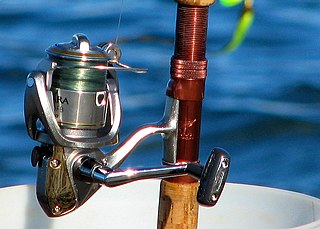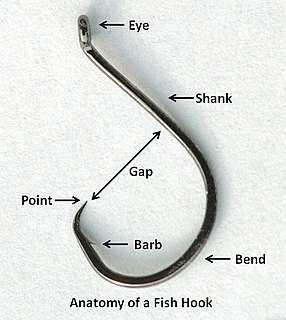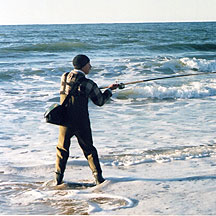Notes
- ↑ "Basic Rod Building Questions & Answers:". www.rodbuilding.org. Retrieved 2022-02-16.
Fishing equipment and methods | ||||||||||||||||||||||||||||
|---|---|---|---|---|---|---|---|---|---|---|---|---|---|---|---|---|---|---|---|---|---|---|---|---|---|---|---|---|
| ||||||||||||||||||||||||||||
| ||||||||||||||||||||||||||||
| Fisheries | ||
|---|---|---|
| Fishing | ||
| Industry | ||
| Recreation | ||
| Techniques | ||
| Tackle | ||
| Locations | ||
Fishing rod tapers describe how much a fishing rod bends or flexes under pressure. Different tapers are used for different fishing scenarios as well as for personal preference.
The action of a taper is described by the flex of the tip of a rod when pressure is applied perpendicular to the rod. Only a section of the rod starting at the tip of the rod should bend while the remainder of the rod should stay rigid.
Variations can be described in three main categories, fast, medium, or slow with variations in between each. A rod with a fast taper will only flex the top 20 percent. Medium fast and medium tapers will flex approximately 30 to 60 percent of the rod respectively. If the rod has a slow taper, almost the entire rod or blank will bend or flex under pressure. [1]
Rod taper is important for several reasons. The feel for the lure being used and the fish being caught dictate the appropriate taper use.
A fast action tip will be used when fishing jig type lures. The angler can feel and therefore control what the lure is doing quite easily. Since only the very tip of the rod bends, when a fish strikes the angler has ample rod shaft and backbone to set the hook correctly.
In contrast to fast tapers, the slow flex rods offer the angler advantages when fighting large fish with light fishing line. This additional flex allows the rod to absorb the force of the fish as opposed to the line. This is often the angler who likes to fish split shot rigs or Lindy rigs for walleye.

Trolling is a method of fishing where one or more fishing lines, baited with lures or bait fish, are drawn through the water. This may be behind a moving boat, or by slowly winding the line in when fishing from a static position, or even sweeping the line from side-to-side, e.g. when fishing from a jetty. Trolling is used to catch pelagic fish such as salmon, mackerel and kingfish.

A fishing rod is a long, flexible rod used by fishermen to catch fish. At its simplest, a fishing rod is a simple stick or pole attached to a line ending in a hook. The length of the rod can vary between 2 and 50 feet. To entice fish, bait or lures are impaled on one or more hooks attached to the line. The line is generally stored on a reel which reduces tangles and assists in landing a fish.

A fishing reel is a cranking reel attached to a fishing rod used in winding and stowing fishing line.

Fly fishing is an angling method that uses a light-weight lure—called an artificial fly—to catch fish. The fly is cast using a fly rod, reel, and specialized weighted line. The light weight requires casting techniques significantly different from other forms of casting. The flies may resemble natural invertebrates, baitfish, or other food organisms.

Angling is a method of fishing by means of a fish hook or "angle". The hook is attached to a fishing line, which is usually manipulated via a fishing rod, although rodless techniques such as handlining also exist. Modern fishing rods are usually fitted with a fishing reel that functions as a cranking device for storing, retrieving and releasing out the line, although Tenkara fishing and cane pole fishing are two rod-angling methods that do not use a reel. The hook itself can be additionally weighted with a tackle called a sinker, and is typically dressed with an appetizing bait to attract the fish, but sometimes a inedible fake bait known as a lure with multiple attached hooks is used in place of a single hook with bait. A bite indicator, such as a float or a quiver tip, is often used to relay underwater status of the hook to the surface.

A fishing lure is a type of artificial fishing bait which is designed to attract the attention of predatory fish, using prey-like appearances, movements, vibrations, bright reflections and flashy colors to appeal to the fish's predation instinct and entice it into striking. Many lures are equipped with one or more hooks that anchor into the fish's mouth when it bites and swallows the lure. Some hookless lures are placed to bait the fish nearer so it can can be impaled with a spear or be captured by hand.

A fish hook or fishhook is a tool for catching fish either by impaling them in the mouth or, more rarely, by snagging the body of the fish. Fish hooks have been employed for millennia by anglers to catch fresh and saltwater fish. In 2005, the fish hook was chosen by Forbes as one of the top twenty tools in human history. Fish hooks are normally attached to some form of line or lure which connects the caught fish to the angler. There is an enormous variety of fish hooks in the world of fishing. Sizes, designs, shapes, and materials are all variable depending on the intended purpose of the fish hook. Fish hooks are manufactured for a range of purposes from general fishing to extremely limited and specialized applications. Fish hooks are designed to hold various types of artificial, processed, dead or live baits ; to act as the foundation for artificial representations of fish prey ; or to be attached to or integrated into other devices that represent fish prey.
A quiver tip is a flexible extension to a fishing rod which is designed to vibrate, or quiver, when a fish takes the bait. The main characteristic of its design is its sensitivity. It is a popular and very effective method of bite indication both on still and running water, and is used far more often in bottom fishing. It is not used in game fishing and is seldom, if ever, used when fishing for very large coarse fish. In essence, the angler watches the tip of the fishing rod to detect bites as opposed to, say, a float or an electronic bite alarm.

A spinnerbait is any of a family of fishing lures that get their name from one or more metal blades shaped so as to spin like a propeller when the lure is in motion, creating varying degrees of flash and vibration that mimic small fish or other prey. The two most popular types of spinnerbaits are the "in-line spinner" and "safety pin" spinnerbaits, though others such as the "tail-spinner" also exist. Spinnerbaits are used principally for catching predatory fish such as perch, pike and bass.

Fishing tackle is the equipment used by anglers when fishing. Almost any equipment or gear used for fishing can be called fishing tackle. Some examples are hooks, lines, sinkers, floats, rods, reels, baits, lures, spears, nets, gaffs, traps, waders and tackle boxes.

A plastic worm is a plastic fishing lure, generally made to simulate an earthworm. Plastic worms can carry a variety of shapes, colors and sizes, and are made from a variety of synthetic polymers. Some are even scented to simulate live bait.

Plugs are a popular type of hard-bodied fishing lure. They are widely known by a number of other names depending on the country and region. Such names include crankbait, wobbler, minnow, shallow-diver and deep-diver. The term minnow is usually used for long, slender, lures that imitate baitfish, while the term plug is usually used for shorter, deeper-bodied lures which imitate deeper-bodied fish, frogs and other prey. Shallow-diver and deep-diver refer to the diving capabilities of the lure, which depends on the size and angle of the lip, and lure buoyancy.

Soft plastic bait, commonly known as just plastic bait, is any of a range of plastic-based fishing baits, termed so because of their soft, flexible rubber texture. Designed to imitate fish or other natural aquatic food sources, their realistic texture and versatility, combined with simple and economical production has led them to become a standard article of modern fishing tackle. Soft plastics are available in a large range of colours, sizes and particularly shapes.
A sabiki or flasher rig is typically fished off boats, piers, jetties, or any structure over the water. Sabikis consist of any number of small hooks, each one on individual dropper lines which are a few inches long. The individual dropper lines are then tied to a longer leader in series, about 6 inches (15 cm) apart; a weight is tied to the end of the leader. The individual hooks are decorated as lures or tied like flies similar to those used in fly fishing. Often they have a simple piece of lumo-infused material or iridescent film attached to them. Traditionally, on any individual rig, all of the lures will be either identical or in an alternating sequence of colors. The type or size sabiki used depends on water conditions, species of fish sought or simply the angler's preference.

Surf fishing is the sport of catching fish standing on the shoreline or wading into the surf. A general term, surf fishing may or may not include casting a lure or bait, and refers to all types of shore fishing – from sandy and rocky beaches, rock jetties, or even fishing piers. The terms surfcasting or beachcasting refer more specifically to surf fishing from the beach by casting into the surf at or near the shoreline. With few exceptions, surf fishing is done in saltwater. The most common misconception about surf fishing is the idea that one must cast as far out as possible in order to reach the fish. At beaches on the west coast of the United States, and in fact, at most beaches around the world, you only really need to get your bait into knee-deep water. This is referred to as surf fishing the "skinny".
Spin fishing is an angling technique where a spinning lure is used to entice the fish to bite. Spin fishing is used in both freshwater and marine environments. Spin fishing is distinguished between fly fishing and bait cast fishing by the type of rod and reel used. There are two types of reels used when spin fishing, the open faced reel and the closed faced reel. The spin fishing rod has no trigger attached to the base of the fishing rod. This is what differentiates the spin fishing rod from the bait casting fishing rod.
Drop shotting is a high finesse technique for fishing plastic baits, and consists of a small thin-wire hook with a weight attached to the tag end of the line. This is in contrast to the more traditional Texas Rig, where the weight slides inline, resting on the nose of the bait, or the Carolina Rig, where the weight is fixed above the bait. The drop shot rig provides the ability to keep a lure off the bottom, with weightless action. Usually the bait is fished by letting the weight hit the bottom and then shaking the lure by twitching the rod. But can also be flipped, dragged, hopped, or jigged along the bottom. This simple, but versatile technique has endless combinations with the different hooks, soft plastics and weights that can be used.[1] The aim is to present a free floating, slow twitching lure to induce a strike from non-aggressive fish. This rig is commonly used for catching Smallmouth Bass, Largemouth Bass, and Spotted Bass, but can be used for a variety of other fish species, as well.
Fly fishing tackle comprises the fishing tackle or equipment typically used by fly anglers. Fly fishing tackle includes:
The wacky rig is a skill technique used for fishing with a soft plastic lure, such as the Gary Yamamoto 'Senko'. Notable for its unique action even among soft lures, wacky style is used to heighten the chance at catching finicky fish on harsh days, although at the expense of lowering the chances of very large fish, because the size of the bait is very small, allowing bass of all sizes to take the bait. Unlike the Texas rig and Carolina rig, both sides of the wacky rig flutter, creating a more natural action. The name comes from its unusual style of attaching a plastic worm through the middle of the body instead of on one end.
The figure eight is a technique used by anglers to fish specifically for the muskellunge. It has been developed due to the nature of the fish's hunting style. Essentially, the figure eight is a final enticement performed by the angler just before lifting the lure out of the water for another cast. To help visualize the concept, think of a roller coaster. As the lure is moved from side to side, it also moves up and down.